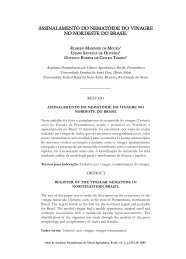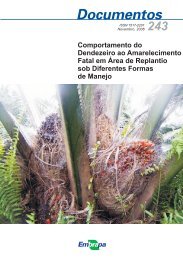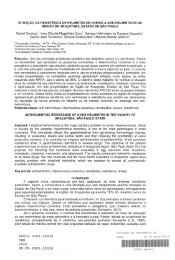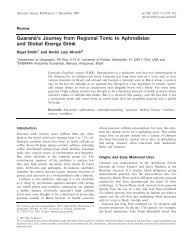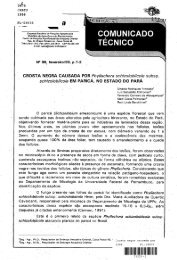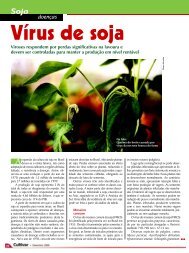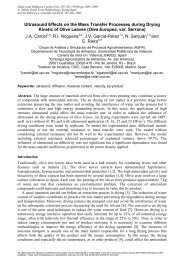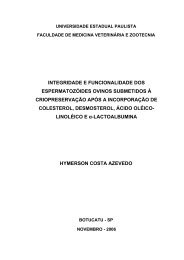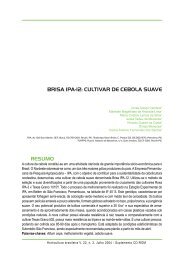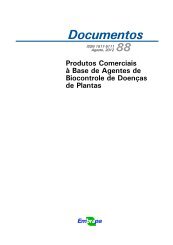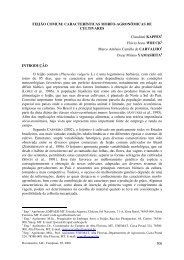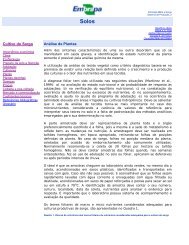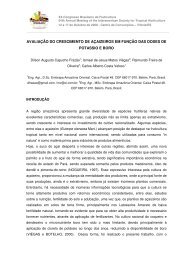Adaptabilidade e Estabilidade de Cultivares de Milho no ... - Embrapa
Adaptabilidade e Estabilidade de Cultivares de Milho no ... - Embrapa
Adaptabilidade e Estabilidade de Cultivares de Milho no ... - Embrapa
Create successful ePaper yourself
Turn your PDF publications into a flip-book with our unique Google optimized e-Paper software.
<strong>Adaptabilida<strong>de</strong></strong> e <strong>Estabilida<strong>de</strong></strong> <strong>de</strong> <strong>Cultivares</strong> <strong>de</strong> <strong>Milho</strong> <strong>no</strong><br />
Meio-Norte do Brasil na Safra <strong>de</strong> 2005/2006<br />
Milton José Cardoso 1 , Hélio Wilson Lemos <strong>de</strong> Carvalho 2 , Paulo Evarista Oliveira Guimarães 3 e Vanice<br />
Dias <strong>de</strong> Oliveira 3<br />
Introdução<br />
O processo <strong>de</strong> recomendação <strong>de</strong> cultivares<br />
baseado <strong>no</strong> <strong>de</strong>sempenho médio superior obtido na<br />
média <strong>de</strong> ensaios realizados em vários ambientes é<br />
<strong>de</strong>saconselhável, uma vez que além <strong>de</strong> não se conhecer<br />
a contribuição ambiental na expressão fe<strong>no</strong>típica <strong>de</strong> um<br />
<strong>de</strong>terminado caráter, corre-se o risco <strong>de</strong> recomendar<br />
materiais que mostraram rendimentos inferiores em<br />
alguns ambientes. Por essa razão, é <strong>de</strong> especial<br />
interesse, que se conheça a adaptabilida<strong>de</strong> e a<br />
estabilida<strong>de</strong> <strong>de</strong> <strong>de</strong>terminado material, para tornar mais<br />
seguro o processo <strong>de</strong> recomendação. Proce<strong>de</strong>ndo<br />
<strong>de</strong>ssa forma, Cardoso et al. [1 e 2] e Carvalho et al. [3]<br />
recomendaram vários cultivares para diferentes<br />
ambientes do Nor<strong>de</strong>ste brasileiro.<br />
Consi<strong>de</strong>rando esses aspectos realizou-se o<br />
presente trabalho com o objetivo <strong>de</strong> se conhecer a<br />
adaptabilida<strong>de</strong> e a estabilida<strong>de</strong> <strong>de</strong> varieda<strong>de</strong>s e híbridos<br />
<strong>de</strong> milho quando submetidas a diferentes ambientes do<br />
Meio-Norte brasileiro.<br />
Material e Métodos<br />
Foram avaliados 42 cultivares <strong>de</strong> milho<br />
(varieda<strong>de</strong>s e híbridos) em oito ambientes do Meio-<br />
Norte do Brasil, sendo quatro <strong>no</strong> estado do Maranhão e<br />
outros quatro, <strong>no</strong> estado do Piauí, na safra <strong>de</strong><br />
2005/2006, em <strong>de</strong>lineamento <strong>de</strong> blocos ao acaso, com<br />
três repetições. As parcelas constaram <strong>de</strong> quatro fileiras<br />
<strong>de</strong> 5,0 m <strong>de</strong> comprimento, espaçadas <strong>de</strong> 0,80 m e com<br />
0,25 m entre covas, <strong>de</strong>ntro das fileiras. Foi mantida uma<br />
planta por cova, após o <strong>de</strong>sbaste.<br />
Os pesos <strong>de</strong> grãos foram tranformados em kg<br />
ha -1 e submetidos a uma análise <strong>de</strong> variância<br />
obe<strong>de</strong>cendo ao mo<strong>de</strong>lo em blocos ao acaso. Após isso,<br />
realizou-se uma análise <strong>de</strong> variância conjunta,<br />
obe<strong>de</strong>cendo-se o critério <strong>de</strong> homogeneida<strong>de</strong> dos<br />
quadrados médios residuais, (Gomes, [5]),<br />
consi<strong>de</strong>rando-se aleatórios os efeitos <strong>de</strong> blocos e<br />
ambientes e, fixo, o efeito <strong>de</strong> cultivares, conforme<br />
Vencovsky & Barriga [6]. As estimativas dos<br />
parâmetros <strong>de</strong> adaptabilida<strong>de</strong> e estabilida<strong>de</strong> foram feitas<br />
segundo Cruz et al. [4].<br />
Resultados e Discussão<br />
Os parâmetros <strong>de</strong> adaptabilida<strong>de</strong> e estabilida<strong>de</strong><br />
estão na Tabela 1, verificando-se que as produtivida<strong>de</strong>s<br />
médias <strong>de</strong> grãos (b 0), variaram entre 4.130 kg ha -1 a 6.580 kg<br />
ha -1 , com média geral <strong>de</strong> 5.355 kg ha -1 , <strong>de</strong>stacando-se com<br />
melhor adaptação as cultivares, que mostraram<br />
produtivida<strong>de</strong>s médias <strong>de</strong> grão acima da média geral<br />
(Vencovsky & Barriga, [6]).<br />
As estimativas <strong>de</strong> b 1 que avalia os <strong>de</strong>sempenhos<br />
das cultivares nas condições <strong>de</strong>sfavoráveis variaram <strong>de</strong><br />
0,47, nas varieda<strong>de</strong>s, Asa Branca e Cruzeta a 1,93, <strong>no</strong><br />
híbrido PL 1335, sendo ambas estatisticamente diferentes da<br />
unida<strong>de</strong> (b 1?1).<br />
Consi<strong>de</strong>rando os materiais que mostraram melhor<br />
adaptação (b 0>média geral), os híbridos, <strong>de</strong>sse grupo, que<br />
mostraram estimativas <strong>de</strong> b 1 > 1, foram exigentes nas<br />
condições <strong>de</strong>sfavoráveis; por outro lado, os que<br />
apresentaram essas estimativas me<strong>no</strong>res que a unida<strong>de</strong> (b 1<br />
< 1), mostraram-se pouco exigentes nessas condições <strong>de</strong><br />
ambiente. Também, nesse grupo <strong>de</strong> materiais <strong>de</strong> melhor<br />
adaptação, aqueles com estimativas <strong>de</strong> (b 1 + b 2 > 1)<br />
respon<strong>de</strong>ram à melhoria ambiental.<br />
No que refere à estabilida<strong>de</strong> <strong>de</strong> produção todos os<br />
materiais mostraram baixa previsibilida<strong>de</strong> <strong>no</strong>s ambientes<br />
consi<strong>de</strong>rados (s 2 d ? 0). Cruz et al. [4] consi<strong>de</strong>ram que<br />
cultivares com valores <strong>de</strong> R 2 > 80% não <strong>de</strong>vem ter seus<br />
graus <strong>de</strong> previsibilida<strong>de</strong> comprometidos. Assim, os híbridos<br />
BRS 1010, PL 1335, BRS 3003, <strong>de</strong>ntre outros, apresentaram<br />
alta estabilida<strong>de</strong> <strong>no</strong>s ambientes estudados.<br />
Consi<strong>de</strong>rando-se os resultados apresentados,<br />
infere-se que as cultivares que apresentaram estimativas <strong>de</strong><br />
b 0 acima da média geral e <strong>de</strong> b 1 e <strong>de</strong> b 1+b 2 > 1 <strong>de</strong>vem ser<br />
recomendadas para os ambientes favoráveis, a exemplo dos<br />
híbridos PL 1335, PL 6880, SHS 4040, <strong>de</strong>ntre outros. Por<br />
ouro lado, cultivares com b 0 > média geral e b 1 < 1 <strong>de</strong>vem ser<br />
sugeridos para as condições <strong>de</strong>sfavoráveis, a exemplo dos<br />
híbridos SHS 5070, SHS 4040, BR 206, <strong>de</strong>ntre outros.<br />
Referências<br />
[1] CARDOSO, M. J..; CARVALHO, H. W. <strong>de</strong> C.; OLIVEIRA, O.<br />
C.; SOUZA, E. M. <strong>de</strong>. 2004. <strong>Adaptabilida<strong>de</strong></strong> e estabilida<strong>de</strong> <strong>de</strong><br />
cultivares <strong>de</strong> milho em diferentes ambientes do Meio-Norte<br />
brasileiro. Revista Ciência Agronômica, Fortaleza, v. 35, n. 1,<br />
p. 68-75.<br />
________________<br />
1. Primeiro Autor é Pesquisador A da <strong>Embrapa</strong> Meio-Norte, sala 256, Teresina, PI, CEP 64006-220. E-mail: milton@cpamn.embrapa..br<br />
2. Segundo Autor é Pesquisador B da <strong>Embrapa</strong> Tabuleiros Costeiros, Aracaju, SE, CEP 49025-040. E-mail: helio@cpatc.embrapa.br<br />
3. Terceiro Autor é Pesquisador A da <strong>Embrapa</strong> <strong>Milho</strong> e Sorgo, Sete Lagoas, MG, CEP 37701-970. E-mail: evaristo@icnpms.embrapa.br<br />
4. Bolsista DTI-G/CNPq/<strong>Embrapa</strong> Tabuleiros Costeiros, vanice_dias@yahoo.com.br<br />
Apoio financeiro: <strong>Embrapa</strong> /Projeto 03.03.1.45.00-06
[2] CARDOSO, M. J.; CARVALHO, H. W. L. <strong>de</strong>; SANTOS, M.<br />
X. dos; LEAL, M. <strong>de</strong> L. da S.; OLIVEIRA, A. C. 2005.<br />
Comportamento fe<strong>no</strong>típico <strong>de</strong> cultivares <strong>de</strong> milho na<br />
região Merio-Nrote brasileira. Revista Ciência<br />
Agronômica, Fortaleza, v.36, n.2, p.181-188.<br />
[3] CARVALHO, H. W. L. <strong>de</strong>; CARDOSO, M. J.; LEAL, M. <strong>de</strong><br />
L. da S.; SANTOS, M. X. dos; SANTOS, D. M. dos;<br />
TAGOSA, J. N.; LIRA, M. A.; SOUZA, E. M. <strong>de</strong>. 2005.<br />
<strong>Adaptabilida<strong>de</strong></strong> e estabilida<strong>de</strong> <strong>de</strong> cultivares <strong>de</strong> milho <strong>no</strong><br />
Nor<strong>de</strong>ste brasileiro <strong>no</strong> a<strong>no</strong> agrícola <strong>de</strong> 2003. Revista Científica<br />
Rural, Bagé, v.10, n.2, p.43-52..<br />
[4] CRUZ, C. D.; TORRES, R. A. <strong>de</strong>; VENCOVSKY, R. 1989. An<br />
alternative approach to the stability analysis by Silva and<br />
Barreto. Revista Brasileira <strong>de</strong> Genética, v.12, p.567 a 580.<br />
[5] GOMES, F. P. 1990. Curso <strong>de</strong> estatística experimental. 8 ed.<br />
São Paulo: Nobel, 450p.<br />
[6] VENCOVSKY, R.; BARRIGA, P.1992. Genética biométrica <strong>no</strong><br />
fitomelhoramento. Ribeirão Preto: Socieda<strong>de</strong> Brasileira <strong>de</strong><br />
Genética, 496p.
Tabela 1. Estimativas das médias e dos parâmetros <strong>de</strong> adaptabilida<strong>de</strong> e estabilida<strong>de</strong> <strong>de</strong> cultivares <strong>de</strong> milho <strong>no</strong> Meio-Norte brasileiro na<br />
safra 2005/2006.<br />
CULTIVARES 1<br />
BRS 1010 H<br />
BRS 1030 H<br />
PL 1335 H<br />
BRS 3003 H<br />
SHS 5050 H<br />
SHS 4060 H<br />
PL 6880 H<br />
BRS 3150 H<br />
SHS 4050 H<br />
SHS 5070 H<br />
BRS 2110 H<br />
SHS 4040 H<br />
SHS 500 H<br />
BRS 2223 H<br />
Produtivida<strong>de</strong>s médias <strong>de</strong> grãos (kg ha -1 ) (b0) R 2 (%)<br />
Geral Desfavorável Favorável<br />
b1 b2 b1+b2 s 2 d<br />
6589 a 6100 7079 1,06** -0,69** 0,37** 270620,6** 82<br />
6468 a 5799 7137 1,38** -1,09** 0,29** 606131,7** 78<br />
6402 a 5482 7321 1,93** -0,12** 1,80** 300763,9** 94<br />
6231 b 5540 6930 1,44** -0,44** 0,99** 308163,5** 89<br />
6219 b 5566 6871 1,40** -0,68** 0,72 487175,1** 82<br />
6169 b 5657 6681 1,11** -0,66** ** 0,45** 131498,8** 91<br />
6152 b 5824 6555 0,79** 1,62** 2,41** 313195,1** 86<br />
6107 b 5525 6689 1,22** -0,59** 0,63** 179169,1** 90<br />
6042 c 5522 6562 1,10** -0,1054** 1,00** 88459,1** 95<br />
5950 c 5697 6204 0,58** 0,04** 0,62** 1425578,2** 24<br />
5936 c 5406 6465 1,09** -0,79** 0,29** 174925,1** 88<br />
5886 c 5513 6259 0,79** 0,73** 1,52 173163,9** 87<br />
5884 c 5233 6536 1,43** 0,39** ** 1,82** 844072,3** 78<br />
5816 c 5307 6325 1,03** -0,37** 0,66** 547513,4** 70<br />
BR 206 H<br />
5774 c 5374 6175<br />
0,76** 0,39** 1,16<br />
813910,2** 53<br />
BRS 2114 H<br />
5743 c<br />
5304 6183 0,91** -0,25** 0,66**<br />
349607,2** 74<br />
CPATC 4 5516 c<br />
5048 5984 0,99** 0,76** 1,75**<br />
92388,5** 95<br />
BRS 2020 H<br />
6384 b<br />
4988 5403 0,41** 1,02** 1,43**<br />
91026,4** 87<br />
AL 34 5296 d<br />
4788 5803 1,07** 0,38** 1,45**<br />
216962,3** 89<br />
CPATC 7 5286 d<br />
4810 5761 1,00** 0,48** 1,48**<br />
28014,2** 98<br />
UFVM 100 5244 d<br />
4689 5849 1,23** 0,07** 1,29**<br />
108141,2** 95<br />
AL 25 5206 d<br />
4749 5661 0,95** 0,23** 1,17**<br />
169449,7** 88<br />
CPATC 3 5202 d<br />
4827 5576 0,81** 0,01** 0,82** 193184,7** 82<br />
AL<br />
Ban<strong>de</strong>irante Sintético<br />
Precoce Sertanejo 1<br />
5190 d<br />
5174 d<br />
5115 d<br />
4763<br />
4726<br />
4786<br />
5617<br />
5622<br />
5444<br />
0,87** -0,23**<br />
0,92** 0,41**<br />
0,68** 0,35**<br />
0,64** 229087,1**<br />
1,33** 379358,7**<br />
1,04** 36758,3**<br />
80<br />
77<br />
95<br />
Sintético 1x 5098 d<br />
4419 5785 1,42** 0,11** 1,53** 116824,8** 96<br />
CPATC 5 5080 d<br />
4675 5485 0,85** -0,19** 0,66** 209701,7** 81<br />
AL Manduri 4953 e<br />
4539 5367 0,87** 0,12** 0,99** 378115,0** 73<br />
Sintético<br />
Dentado São Francisco<br />
4912 e<br />
4889 e<br />
4188<br />
4625<br />
5637<br />
5152<br />
1,62** -0,63**<br />
0,56** 0,42**<br />
0,98** 1097220,9**<br />
0,98** 180669,5**<br />
74<br />
75<br />
Cruzeta 4857e<br />
4646 5067 0,47** 0,23** 0,70** 379346,0** 47<br />
Sintético 2x 4827e 4123 5532<br />
1,52** -0,23** 1,29** 1048689,4** 73<br />
Asa Branca 4803 e 4576 5030<br />
0,47** 1,11** 1,57**<br />
180093,2** 81<br />
Potiguar 4746 f 4347 5145<br />
0,86** -0,20** 0,65**<br />
206694,8** 81<br />
Gurutuba 4703 f<br />
4175 5231 1,03** -0,05** 0,98** 930950,3** 59<br />
SHS 3031 4616 f<br />
4206 5027 0,88** -0,55** 0,32** 276830,1** 76<br />
UFVM 200 4504 f<br />
4090 4918 0,84** -0,66** 0,19** 394839,1** 67<br />
Assum Preto 4373 g<br />
3931 4814 0,91** 0,14** 1,06** 356616,6** 76<br />
Caatingueiro 4297g<br />
3881 4714 0,86** -0,15** 0,72** 151905,2** 86<br />
BR 106 4179 g<br />
3743 4614 0,93** 0,40** 1,34<br />
493563,1** 73<br />
BR 473 4130 g<br />
3695 4564 0,93** -0,73** 0,20**<br />
467485,2** 67<br />
1<br />
As cultivares cujos <strong>no</strong>mes são seguidos da letra H são híbridos e as <strong>de</strong>mais são varieda<strong>de</strong>s. * e ** significativamente diferente da unida<strong>de</strong>,<br />
para b1 e b1+b2, e <strong>de</strong> zero, para b2 a 5% e a 1% <strong>de</strong> probabilida<strong>de</strong> pelo teste t <strong>de</strong> Stu<strong>de</strong>nt, respectivamente. ** significativamente diferente <strong>de</strong><br />
zero, pelo teste F, Q.M. do <strong>de</strong>svio. As médias seguidas pelas mesmas letras não diferem entre si pelo teste Scott-K<strong>no</strong>tt ao nível <strong>de</strong> 5% <strong>de</strong><br />
probabilida<strong>de</strong>.



